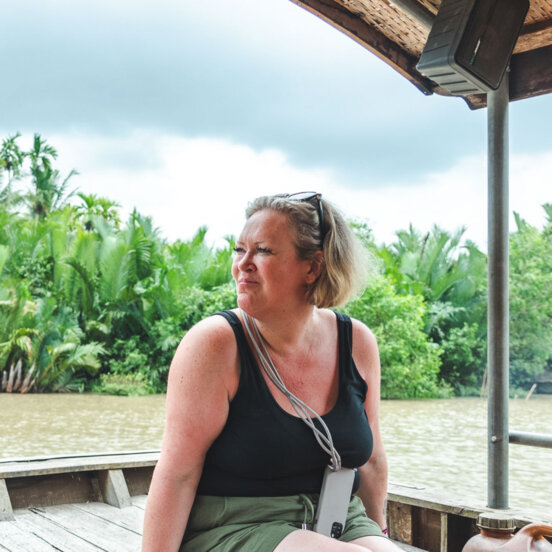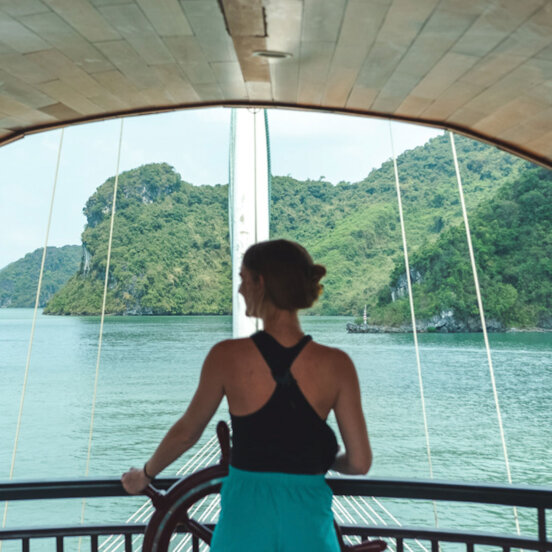My 200-mile Arctic dog-sledding trip was the ultimate adventure for ordinary people

When you’re straddling the runners of a dog sled, feet just inches from the snow and ice racing beneath you, even 20mph feels faster than speeding down the motorway in a sports car. Yet somehow, it’s as exhilarating as it is meditative. It’s thrilling yet grounding. Chaotic yet calm.
I never thought I’d be the kind of person to get on a dog sled. Until now, it’s been the type of activity that feels decisively on the list of “extreme adventures,” and something you must surely need a licence, or experience, to do.

I could hear the Alaskan and Siberian huskies before I could see them
So, when I was invited to join the Fjällräven Polar, sledding a portion of the 186-mile expedition trail that laces above the Arctic Circle from Signaldalen in Norway, along the ancient Sami trade route of Råstojaure, into Sweden, I was immediately intrigued. After all, the Polar is specifically built to show “ordinary people,” much like myself, that all you need is the right gear and some guidance to pursue the adventure of a lifetime. So, I figured, why not?
When I arrived at the Fjellborg kennels in Kiruna, Sweden’s northernmost town and gateway to the country’s portion of the Arctic Circle, I could hear the 200 Alaskan and Siberian huskies used in the race, long before I could see them.

I got a quick tutorial on how it works
A guide told us that sled dogs are the opposite of snowmobiles, which remain deadly silent until you start moving. The dogs, on the other hand, are incredibly loud until you pull up the sled anchor and give them permission to run. Then, they’re silent, intently focused on their mission to move as fast as they can, as far as they can, for as long as you’ll let them.
After I met my team of four dogs and hopped onto my sled, I got a quick tutorial on how it works. It’s simple, really: if the sled isn’t anchored to anything, or if you’re not applying firm pressure to the brake, the dogs are able to run. And, if they’re able to, they will…

If you let go of the sled, the dogs could keep running
I was nervous as I anticipated the start of the trail. “What if I fall off?” I wondered. I remembered dogsledder Blair Braverman’s commands from her book, Welcome to the Goddamn Ice Cube, about learning the trade in Norway before becoming a guide in Alaska: never, ever let go of the sled, she says. Not under any circumstances.
If you let go of the sled, the dogs could keep running for miles without you, and having all your supplies run away without you is the last thing you want when you’re surrounded by a frozen landscape.

I was instructed to use all my weight on the soft brake
To hit the trail, we had to go down a short hill. It would have barely felt like a slope on foot but was akin to a rollercoaster being pulled by four huskies. The sled has a “soft” brake that’s like a studded rubber mat to step on to slow down the dogs. The “hard” brake is a metal bar with two spikes to dig into the ice and prevent the sled from moving forward.
I was one of the smaller mushers – the term used for the person driving the sled – so I was instructed to use all my weight on the soft brake as we headed downhill. I couldn’t see my knuckles through my heavy mittens but I imagined they were as white as the snow, as the dogs took off and fell silent in concentration.

It was easier than I expected
We were moving, and fast. Miraculously, down the first hill, across expansive fields of snow and ice and through narrow stands of short trees, I stayed upright. I relaxed and took my foot off the brake as the trail levelled out in front of me and we left the kennel behind. It was easier than I expected, and calming to let the dogs navigate the trail while I got to enjoy the scenery.
The Fjällräven Polar started in 1997 after the Swedish founder of the company, Åke Nordin, met fellow countryman and dog sledder, Kenth Fjellborg. Fjellborg had competed in the Iditarod, Alaska’s 1,000-mile dog-sled race, and Nordin wanted to create a similar experience in the Swedish wilderness for people with no experience of the sport.

The winners go to Sweden and hit the trail
He figured that, with the right training, essential gear and attitude, anyone could do it. And so, nearly every year since, the company has run a competition for anyone in the world to apply for a spot on the Polar.
The winners go to Sweden and hit the trail after some instruction about caring for their dogs, rigging their sleds and camping in the snow. They arrive with potentially zero relevant skills – one participant I met told me he’d never even pet a dog before arriving – and leave with the experience of a lifetime.
In the film Tracks, based on Robyn Davidson’s book about crossing the Australian desert with camels, Robyn (played by Mia Wasikowska), says she’d “like to believe an ordinary person is capable of anything.” If I didn’t believe that before, I certainly believe it now. Against all odds, I kept that promise to never let go of the sled, even when I did fall.

My sled teetered to one side and then tipped over
It happened when we went around a tight curve that had toppled the sled of a musher in front of me who’d taken it too fast. I saw it coming and thought mine might topple, too, but I remembered Braverman’s advice. I repeated it as a mantra to myself as I tried to slow the dogs: never let go. Never let go. NEVER. LET. GO.
My sled teetered to one side and then tipped over, tossing me into a snowbank. But somehow, I managed to hold my grip. The dogs kept running, dragging the toppled sled with me trailing behind, holding onto the handlebar.

It’s easily the coolest thing I’ve ever done
Somehow, whether by willpower or sheer dumb luck, the sled tipped back up as I clung to it. On my feet, I ran alongside, refusing to let go, and then jumped, landing back on the sled where I should have been all along. The rest of my group cheered with such excitement and happy disbelief at the display. I felt like I’d landed a perfect score for an Olympic gymnastics routine. It’s easily the coolest thing I’ve ever done.
When we crossed the finish line of the Polar the next day, we checked into the Väkkärä Lodge. Of course, as is tradition in Scandinavia, a large sauna awaited. It had expansive windows with a view of the frozen Lake Väkkärä, where a ladder stuck out from a jagged hole in the ice.

I’d gone to Sweden for a good challenge
The idea was to heat up in the sauna to near boiling point, and then run out barefoot through the snow, descend the ladder, and treat our muscles to a literal ice bath. Frigid.
The sauna bit was easy, but of course, when it came time to leave its warmth and go out into the snow, I hesitated. I had just spent hours bundled up to my nose trying not to get cold. Shouldn’t I just relish the warmth? Then again, I’d gone to Sweden for a good challenge, and generations of Swedes haven’t perfected the sauna/cold plunge routine for nothing. I felt emboldened by the dog sledding. How many times in your life do you get to say you’ve taken a dip in a frozen Arctic lake? I couldn’t turn down the opportunity.

Thanks to the Arctic I’ve held a commitment to try new things
The snow felt good on my toes for the first step or two, when my skin was hot enough to melt it, but quickly my feet started growing numb. I shrieked as I ran for the lake, to the laughter of other mushers relaxing on the lodge’s patio. Let’s just say I did not maintain a sled dog’s silent, focused composure as I descended the ladder. I’m sure I resembled something much more like a fish out of water as I ducked under the surface and catapulted myself straight back out, flailing and gasping as I bolted back to the sauna.
I flung open the door to the sauna and almost immediately felt my body coming back to life. As it turns out, that thawing feeling is pretty addictive. Thanks to the Arctic, and to the exhilaration of pushing the boundaries of ordinary into extraordinary territory, I’ve held on tight to a commitment to keep trying new things. My next challenge? Cold-water swimming.
For your own Arctic adventure, join Flash Pack’s four-day Finland trip, which ticks off a private island in the Arctic Circle, a snowmobile safari and a cross-country ski trek.
Got a story or adventure that could inspire a solo traveller like you? Tag @flashpack on social or email [email protected] to be featured.
Images: Courtesy of Fjällräven Polar/Kassondra Lee Closs & Adobe Stock










